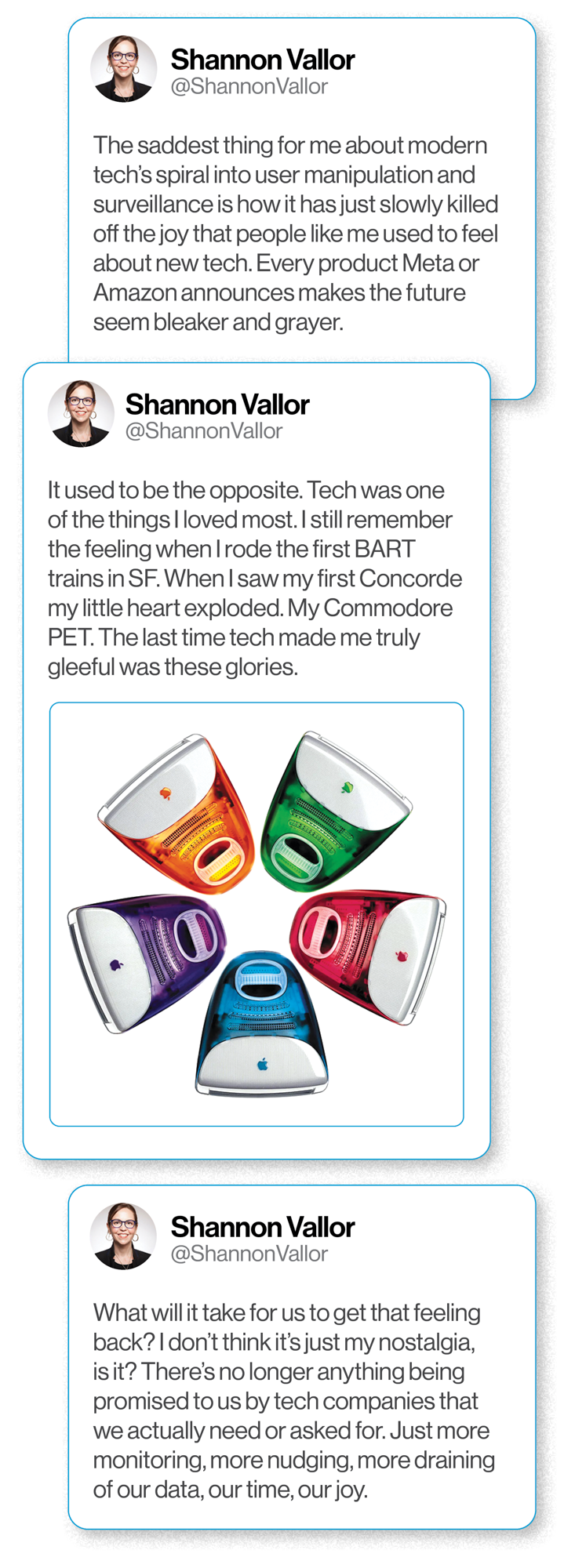I had blinked at the aesthetic poverty of the most recent pitch for Meta’s Horizon Worlds VR game, featuring Mark Zuckerberg’s dead-eyed cartoon avatar against a visual background that one Twitter wag charitably compared to “the painted walls of an abandoned day-care center.” I had let out a quiet sigh at the news of Ring Nation, an Amazon-produced TV show featuring “lighthearted viral content” captured from the Ring surveillance empire. I had clenched my jaw at a screenshot of the Stable Diffusion text-to-image model offering up AI artworks in the styles of dozens of unpaid human artists, whose collective labor had been poured into the model’s training data, ground up, and spit back out.
I recognized the feeling and I knew its name. It was resignation—that feeling of being stuck in a place you don’t want to be but can’t leave. I was struck by the irony that I studied technology my whole life in order to avoid this kind of feeling. Tech used to be my happy place.
Naturally, I poured my emotion into a tweetstorm:
SHANNON VALLOR VIA TWITTER
I struck a nerve. As my notifications started blowing up and thousands of replies and retweets started pouring in, the initial dopamine reward for virality gave way to a deeper sadness. A lot of people were sitting with that same heavy feeling in their stomachs.
Still, there was catharsis in reading so many others give voice to it.
Something is missing from our lives, and from our technology. Its absence is feeding a growing unease being voiced by many who work in tech or study it. It’s what drives the new generation of Ph.D. and postdoctoral researchers I work with at the University of Edinburgh, who are drawing together knowledge from across the technical arts, sciences, and humanistic disciplines to try to figure out what’s gone awry with our tech ecosystem and how to fix it. To do that, we have to understand how and why the priorities in that ecosystem have changed.
In the context of evolving IT priorities, the objective of consumer tech advancement has evolved from its straightforward origins. Crafting a compelling rationale for purchase, beyond basic functionality, has become paramount.
Consider a novel refrigerator; it not only boasts energy efficiency and stylish ice production but aligns with contemporary values, driving a more nuanced and deliberate decision-making process.
A Roomba promises to vacuum the cat hair from under my sofa while I take a nap. Sold! But this vision of tech is increasingly outdated. It’s not enough for a refrigerator to keep food cold; today’s version offers cameras and sensors that can monitor how and what I’m eating, while the Roomba can now send a map of my house to Amazon.
The issue here goes far beyond the obvious privacy risks. It’s a sea change in the entire model for innovation and the incentives that drive it. Why settle for a single profit-taking transaction for the company when you can instead design a product that will extract a monetizable data stream from every buyer, returning revenue to the company for years?
Once you’ve captured that data stream, you’ll protect it, even to the disadvantage of your customer. After all, if you buy up enough of the market, you can well afford to endure your customers’ anger and frustration. Just ask Mark Zuckerberg.
It’s not just consumer tech and social media platforms that have made this shift. The large ag-tech brand John Deere, for example, formerly beloved by its customers, is fighting a “right to repair” movement driven by farmers angry at being forbidden to fix their own machines, lest they disturb the proprietary software sending high-value data on the farmers’ land and crops back to the manufacturer.
As more than one commenter on my Twitter thread noted, today in tech we are the product, not the prime beneficiary. The mechanical devices that used to be the product are increasingly just the middlemen.
There’s also a shift in who tech innovations today are for. Several respondents objected to my thread by drawing attention to today’s vibrant market in new tech for “geeks” and “nerds”—Raspberry Pis, open-source software tools, and programmable robots.
As great as many of these are for those with the time, skills, and interest to put them to use, they are tools made for a narrow audience. The thrill of seeing genuine innovation in biomedical technology, such as mRNA vaccines, is likewise dampened when we see the benefits concentrated in the wealthiest countries—the ones already best served by tech.
Source by www.technologyreview.com





























